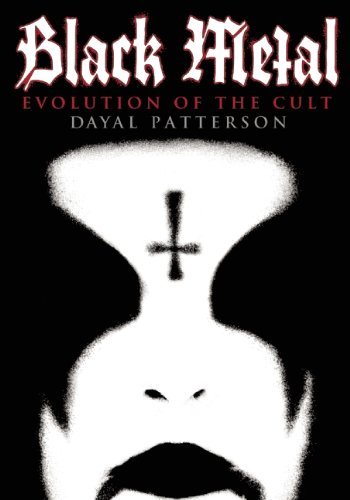Black Metal: The Evolution of the Cult is the first book that I'm aware of that treats the subject of black metal music with academic seriousness. Journalist and photographer Dayal Patterson is clearly aware that history is messy and non-linear, yet he still successfully gives the reader an overall picture of an underground scene that spanned several continents over almost three decades.
Surprisingly, up until now, Lords of Chaos: The Bloody Rise of the Satanic Metal Underground by Michael Moynihan and Didrik Søderlind was the leading book on the subject. Lords focused on the satanic underground of Norway, namely the murder, suicides, church burnings and the more salacious side of the early '90s black metal scene. In contrast Black Metal: The Evolution of the Cult focuses on the music and the people all over the world who make up a loosely knit underground community while still addressing the outrageous, oddly ending up with a higher body count than Lords of Chaos.
The first wave of black metal consisted of Venom, Mercyful Fate, Celtic Frost/Hellhammer, and perhaps most importantly, Bathory. Bathory seemed like the band that took it out of the cartoonish, show business side of this nascent genre and made things more serious. The following generation that came of age in the late '80s and '90s took things to the extreme. Bands such as Mayhem, Burzum, Thorns, Emperor, Gehenna and many others represented a shift where the lines of art and life became blurred.
Wave after wave emerged as the story begins to spread out around the world. Artists such as Budapest's Tormentor, France's Le Legions Noires collective, Poland's Behemoth and Japan's weirdly wonderful Sigh brought this music out of Scandinavia to new audiences who would in turn resuscitate it whenever it started to become stale.
A great point of contention within the orthodoxy of Black Metal is the use of Satanism and religion. Spirituality generally plays a large part for most of these bands, more so than politics. This subject leads the conversation throughout the book as to what is "true black metal" and what is not. This inevitably leads to fanaticism and I think that is what gives this subculture a cult-like feeling. Many of the protagonists sincerely feel that this music is more than art and identity, it's a way of being in the world.
Black metal has splintered out into hundreds of different subcultures in the past two and a half decades. The artists in the genre have embraced electronic (Blacklodge), Viking Metal (Enslaved) shoegaze (Alcest), psychedelia (Mysticum) folk (Windir) and unfortunately national socialism (Graveland) among other subgenres. While black metal continues to open up, there are still a number of bands that have become black metal traditionalists, and have accepted black metal as a creative straightjacket.
Mr. Patterson's style is crisp and he doesn't tend to editorialize too much. Black Metal is a dense and fascinating 500 pages. Chapters are dedicated to the bands and subgenres that had the most impact both to its musicians and on the national stage. Black Metal: Evolution of the Cult is a reference book, yet I read it from cover to cover, stopping often to consult Spotify, YouTube and Google for supplemental information. There's a lot in this book that the most educated metal head won't know about.
An obsession with music is a constantly rewarding experience. Whether one is reading Can't Stop, Won't Stop: The History of the Hip Hop Generation by Jeff Chang or We Got the Neutron Bomb: The Untold Story of LA Punk by Marc Spitz and Brendan Mullen, journalists are indexing subcultures and writing the history. Myths are created and scores are settled. As a documentary director, I come up against the same historical problems regarding myth, accuracy and belief. Is the role of the journalist or documentary director about untangling the myths, or presenting facts for a viewers and readers to decode?
Black Metal: Evolution of The Cult is published by the infamous Feral House. I highly recommend it to anyone who feels they could benefit from Mr. Patterson's tireless research.
While many of the titles were familiar to me, many were not. Here's a short list of records I discovered and became obsessed with while reading this book:
Trelldom - Til Et Annet..
Gehenna - Seen Through The Veils of Darkness
Thorns - Thorns
Samael - Worship Him
Ulver - Kveldssanger
Ulver - Childhood's End
Mysticum - Planet Satan
Enslaved - Eld
Satyricon - Dark Medieval Times
Mutiilation - Black Millenium
Sigh - Scenario IV: Dread Dreams
Sodom - Get What You Deserve
Click here for a Spotify playlist I put together of above records.
*Caution: some of these titles veer very far from traditional black metal.

